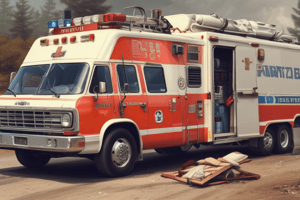Podcast
Questions and Answers
What is the primary responsibility of the Treatment Sector concerning patient management?
What is the primary responsibility of the Treatment Sector concerning patient management?
- To ensure all patients are triaged and monitored appropriately (correct)
- To only treat patients in a designated area
- To determine the medical history of all patients
- To assign a single nurse to oversee all patient treatment
Which of the following procedures is NOT part of the Treatment Sector's responsibilities?
Which of the following procedures is NOT part of the Treatment Sector's responsibilities?
- Assigning and supervising treatment teams
- Establishing a large treatment area
- Providing frequent progress reports to Command
- Conducting post-incident evaluations (correct)
How should the Treatment Sector determine whether to treat patients 'in place' or in a designated treatment area?
How should the Treatment Sector determine whether to treat patients 'in place' or in a designated treatment area?
- Only dictated by the commanding officer's decision
- By random selection of active units on the ground
- In collaboration with Triage and Extrication Sectors (correct)
- Based on patient preference and location
When establishing a treatment area, which factor is crucial for its location?
When establishing a treatment area, which factor is crucial for its location?
What should the Treatment Sector officer do to facilitate the arrival of patients in a designated treatment area?
What should the Treatment Sector officer do to facilitate the arrival of patients in a designated treatment area?
In what scenario should the Treatment Sector focus on treating IMMEDIATE patients?
In what scenario should the Treatment Sector focus on treating IMMEDIATE patients?
Which group of personnel is generally assigned to each patient for treatment?
Which group of personnel is generally assigned to each patient for treatment?
What is a significant operational aspect that the Treatment Sector must regularly communicate to Command?
What is a significant operational aspect that the Treatment Sector must regularly communicate to Command?
What is the primary purpose of establishing separate 'IMMEDIATE' and 'DELAYED' treatment areas?
What is the primary purpose of establishing separate 'IMMEDIATE' and 'DELAYED' treatment areas?
What should be done with patients arriving at the treatment area who have not been triaged?
What should be done with patients arriving at the treatment area who have not been triaged?
During a major incident, what is the recommended initial objective for personnel allocation?
During a major incident, what is the recommended initial objective for personnel allocation?
What action should be taken once all IMMEDIATE patients have been treated?
What action should be taken once all IMMEDIATE patients have been treated?
What is the role of the triage team at the treatment area entrance?
What is the role of the triage team at the treatment area entrance?
Which personnel is primarily assigned to the DEEPLY treatment area?
Which personnel is primarily assigned to the DEEPLY treatment area?
How should patients be arranged in the treatment area to facilitate effective care?
How should patients be arranged in the treatment area to facilitate effective care?
Which geographic designations should be used for multiple treatment areas?
Which geographic designations should be used for multiple treatment areas?
What is the responsibility of the Treatment Sector officer in relation to non-fire department medical personnel?
What is the responsibility of the Treatment Sector officer in relation to non-fire department medical personnel?
What should be documented on the triage tag for each patient?
What should be documented on the triage tag for each patient?
What is the main consideration for the size of the treatment area established by the Treatment Sector?
What is the main consideration for the size of the treatment area established by the Treatment Sector?
Which task is essential for the Treatment Sector to ensure the safety and accountability of patients?
Which task is essential for the Treatment Sector to ensure the safety and accountability of patients?
When establishing a treatment area, what should be done to prepare for the arrival of patients?
When establishing a treatment area, what should be done to prepare for the arrival of patients?
How should the Treatment Sector manage treatment teams for efficient patient care?
How should the Treatment Sector manage treatment teams for efficient patient care?
What is the primary goal concerning IMMEDIATE patients during triage and treatment?
What is the primary goal concerning IMMEDIATE patients during triage and treatment?
What must the Treatment Sector officer notify Command of after the treatment process?
What must the Treatment Sector officer notify Command of after the treatment process?
How are IMMEDIATE patients distinguished for treatment in the field?
How are IMMEDIATE patients distinguished for treatment in the field?
What must be coordinated by the Treatment Sector with respect to the Triage Sector?
What must be coordinated by the Treatment Sector with respect to the Triage Sector?
What is the main purpose of using red and yellow salvage covers in treatment areas?
What is the main purpose of using red and yellow salvage covers in treatment areas?
How should patient placement be organized within the treatment areas?
How should patient placement be organized within the treatment areas?
During a major incident, how many rescuers are generally allocated per patient in the Treatment Sector?
During a major incident, how many rescuers are generally allocated per patient in the Treatment Sector?
What action must be taken for non-triaged patients arriving at the treatment area?
What action must be taken for non-triaged patients arriving at the treatment area?
What is a critical responsibility of the Treatment Sector officer regarding the triage team?
What is a critical responsibility of the Treatment Sector officer regarding the triage team?
How should treatment personnel respond to significant changes in a patient's condition?
How should treatment personnel respond to significant changes in a patient's condition?
What is the expected outcome after all IMMEDIATE patients have been treated?
What is the expected outcome after all IMMEDIATE patients have been treated?
What role do geographic designations play in treatment area organization?
What role do geographic designations play in treatment area organization?
What is essential for the smooth operation of the Treatment Sector during a major incident?
What is essential for the smooth operation of the Treatment Sector during a major incident?
How are ALS and BLS personnel distributed between IMMEDIATE and DELAYED treatment areas?
How are ALS and BLS personnel distributed between IMMEDIATE and DELAYED treatment areas?
Study Notes
Treatment Sector Responsibilities
- Determine if patient treatment will occur “in place” or in a specific treatment area, coordinating with Triage and Extrication Sectors.
- Identify needed resources for effective treatment operations.
- Set up a large treatment area; if the incident is significant, create separate “Immediate” and “Delayed” treatment zones.
- Assign and oversee treatment teams to ensure efficient patient care.
- Ensure every patient is triaged, assessed, and re-triaged as necessary.
- Implement aggressive treatment and rapid patient packaging for efficient transport.
- Provide regular progress updates to Command regarding patient status.
- Maintain safety and accountability for all patients and assigned personnel.
- Confirm transportation priorities in collaboration with the Transportation Sector.
- Facilitate coordination between various operational sectors during an incident.
- Inform Command when all patients have been evacuated from the treatment area.
- Treatment Sector officers will wear identifiable sector vests for easy recognition.
- When treating in place, direct crews to specific patients, ensuring timely assistance by other units.
- Focus initial efforts on treating IMMEDIATE patients, easily identified by night-reflective labels.
- If using a designated treatment area, prepare for incoming patients from the Extrication Sector and ensure clear entry points.
- Ensure the treatment area is safe, accessible, and spacious enough for patients and treatment personnel.
- For large incidents, establish multiple treatment areas with geographic designations (e.g., “East Treatment”, “West Treatment”).
- Use traffic cones, signs, and salvage covers to mark the entrances and differentiate IMMEDIATE from DELAYED care areas.
- Maintain a ratio of one treatment personnel for every four patients as a starting objective during significant incidents.
- Organize patients in the treatment area with sufficient space between them for treatment.
- Non-triaged patients arriving must be tagged at the treatment area entrance by a designated triage team.
- Forward a “Triage Update” to Command for newly-discovered patients needing attention.
- Continuously reassess all patients in the treatment area to ensure appropriate triage classification.
- Assign ALS treatment predominantly in the "IMMEDIATE" area, while BLS personnel mostly oversee the "DELAYED" area.
- Document medical information, vital signs, and treatment on the triage tag for all patients.
- Supervise non-fire department medical personnel actively, ensuring they work under the Treatment Sector officer or designated leaders.
- If a patient’s condition alters significantly, adjust their treatment priority as necessary, involving the Treatment Sector officer.
- After treating all IMMEDIATE patients, assess DELAYED patients with serious mechanisms of injury for potential prioritization into IMMEDIATE status.
Treatment Sector Responsibilities
- Determine if patient treatment will occur “in place” or in a specific treatment area, coordinating with Triage and Extrication Sectors.
- Identify needed resources for effective treatment operations.
- Set up a large treatment area; if the incident is significant, create separate “Immediate” and “Delayed” treatment zones.
- Assign and oversee treatment teams to ensure efficient patient care.
- Ensure every patient is triaged, assessed, and re-triaged as necessary.
- Implement aggressive treatment and rapid patient packaging for efficient transport.
- Provide regular progress updates to Command regarding patient status.
- Maintain safety and accountability for all patients and assigned personnel.
- Confirm transportation priorities in collaboration with the Transportation Sector.
- Facilitate coordination between various operational sectors during an incident.
- Inform Command when all patients have been evacuated from the treatment area.
- Treatment Sector officers will wear identifiable sector vests for easy recognition.
- When treating in place, direct crews to specific patients, ensuring timely assistance by other units.
- Focus initial efforts on treating IMMEDIATE patients, easily identified by night-reflective labels.
- If using a designated treatment area, prepare for incoming patients from the Extrication Sector and ensure clear entry points.
- Ensure the treatment area is safe, accessible, and spacious enough for patients and treatment personnel.
- For large incidents, establish multiple treatment areas with geographic designations (e.g., “East Treatment”, “West Treatment”).
- Use traffic cones, signs, and salvage covers to mark the entrances and differentiate IMMEDIATE from DELAYED care areas.
- Maintain a ratio of one treatment personnel for every four patients as a starting objective during significant incidents.
- Organize patients in the treatment area with sufficient space between them for treatment.
- Non-triaged patients arriving must be tagged at the treatment area entrance by a designated triage team.
- Forward a “Triage Update” to Command for newly-discovered patients needing attention.
- Continuously reassess all patients in the treatment area to ensure appropriate triage classification.
- Assign ALS treatment predominantly in the "IMMEDIATE" area, while BLS personnel mostly oversee the "DELAYED" area.
- Document medical information, vital signs, and treatment on the triage tag for all patients.
- Supervise non-fire department medical personnel actively, ensuring they work under the Treatment Sector officer or designated leaders.
- If a patient’s condition alters significantly, adjust their treatment priority as necessary, involving the Treatment Sector officer.
- After treating all IMMEDIATE patients, assess DELAYED patients with serious mechanisms of injury for potential prioritization into IMMEDIATE status.
Studying That Suits You
Use AI to generate personalized quizzes and flashcards to suit your learning preferences.
Description
This quiz covers the essential responsibilities of the Treatment Sector during emergency response scenarios. Participants will learn how to identify treatment areas, coordinate with other sectors, and supervise treatment teams effectively. Test your knowledge on how to manage resources and establish treatment protocols.




